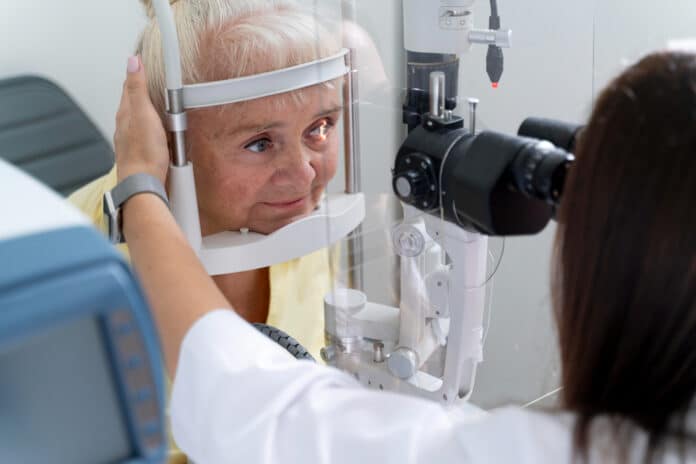A groundbreaking medical study has demonstrated promising outcomes in cornea repair through novel cell therapy. Conducted as a Phase I trial, this research focuses on repairing damaged corneas using a patient’s stem cells, representing a significant advancement in regenerative medicine.
Researchers from Mass Eye and Ear, part of Mass General Brigham, led a team that conducted a phase I trial of a new stem cell treatment called cultivated autologous limbal epithelial cell transplantation (CALEC). The treatment was tested on four patients with severe chemical burns in one eye.
The study, published in Science Advances on August 18, found that CALEC was safe and well-tolerated over the short term. The patients who were followed for a year experienced healing of their cornea surfaces – two could undergo a corneal transplant, and two saw improved vision without more treatment.
While the trial’s main goal was to test safety and feasibility before moving to the next phase, the early results encouraged the researchers. The study’s lead author, Ula Jurkunas, MD, explained that CALEC could provide hope for patients with severe cornea injuries who had no treatment options with good safety records before. She believes that with more research, CALEC could become an essential solution for people who can’t have artificial cornea transplants due to their injuries.
In the CALEC treatment, doctors take stem cells from the patient’s healthy eye using a small piece of tissue. These cells are then grown and multiplied using a unique process at Dana-Farber Cancer Institute. It takes about two to three weeks. After that, the new cells are placed back at Mass Eye and Ear and put into the eye with the damaged cornea.
This project is a teamwork effort involving doctors and researchers from different places. Ula Jurkunas and her Mass Eye and Ear team work with researchers at Dana-Farber Cancer Institute, Boston Children’s Hospital, and the JAEB Center for Health Research. This clinical trial is significant because it’s the first time the National Eye Institute (NEI), part of the National Institutes of Health (NIH), has funded a study on a human stem cell treatment.
When people suffer chemical burns or severe eye injuries, they might lose important cells around their cornea, leading to vision loss and discomfort. These patients can’t get artificial cornea transplants, which are the usual way to fix this. The CALEC procedure tries to fix this issue using the person’s stem cells. These stem cells are grown and multiplied to create a layer of cells that can help the eye heal.
Previous treatments had problems, and the CALEC procedure tried to solve them. The unique thing is that it uses a small number of the person’s stem cells and grows them to make a sheet of cells that help the eye heal naturally.
Ritz, executive director of the Connell and O’Reilly Families Cell Manipulation Core Facility at Dana-Farber and professor of medicine at Harvard Medical School said, “It was challenging to develop a process for creating limbal stem cell grafts that would meet the FDA’s strict regulatory requirements for tissue engineering. Having developed and implemented this process, it was gratifying to see encouraging clinical outcomes in the first cohort of patients enrolled in this clinical trial.”
The researchers said that even though there have been important studies about using a person’s own stem cells for 25 years and Europe has used similar methods, no research team in the U.S. could create a way to make the cells and test them properly. They needed to meet the rules set by the U.S. Food and Drug Administration (FDA) and show that the treatment worked well for patients.
Studies like this show that using cell therapy can be a hope for treating conditions that don’t have a cure yet. The Gene and Cell Therapy Institute at Mass General Brigham helps turn research discoveries into natural treatments for patients. Their way of working involves different experts, which allows them to move quickly and improve treatments for people.
Five patients with eye injuries from chemical burns participated in a phase I study. Four of them received the CALEC treatment. They were followed for 12 months.
The first patient, a 46-year-old man, got better after CALEC and could have an artificial cornea transplant. The second, a 31-year-old man, fully improved from his symptoms, and his vision went from 20/40 to 20/30. The third, a 36-year-old man, also improved a lot. He could see more clearly, from just seeing waving hands to seeing things at 20/30 vision.
The fourth, a 52-year-old man, didn’t have successful results at first, but he got better after trying CALEC again three years later. He went from just being able to see moving hands to counting fingers. He also had an artificial cornea transplant.
The researchers are planning the next phase of the study with 15 more CALEC patients. They’ll be followed for 18 months to see how well the treatment works. They hope CALEC can be an option for patients who couldn’t get better with other medicines.
NEI/NIH grants funded this study, a significant effort involving many doctors and researchers. The CALEC procedure is still being worked on and has a patent pending. The researchers are also part of Ocucell, which wants to develop eye therapies using cells.
Journal Reference:
- Ula V. Jurkunas, Jia Yin et al., Cultivated autologous limbal epithelial cell (CALEC) transplantation: Development of manufacturing process and clinical evaluation of feasibility and safety. Science Advances. DOI: 10.1126/sciadv.adg6470.
